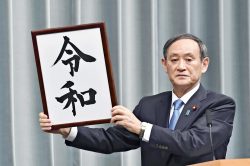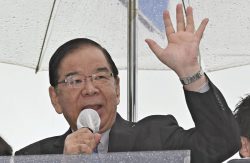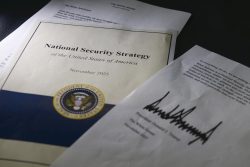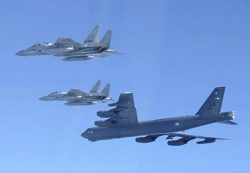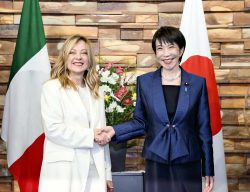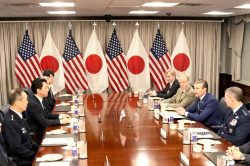11:28 JST, December 1, 2022
China, which proclaims itself to be a maritime power, has repeatedly carried out coercive activities around the Nansei Islands. There is an urgent need for Japan to build a strong system in order to protect its land and ocean territory.
In late November, four China Coast Guard vessels entered Japanese territorial waters off the Senkaku Islands. Japan Coast Guard patrol boats ordered the Chinese vessels to leave. The Chinese ships left the territorial waters about 11 hours later. One of the four Chinese vessels was equipped with a large, naval-sized machine gun, according to Japanese maritime authorities.
There is concern that there could be a case in the future in which the JCG, which guards Japan’s territorial waters, will not be able to respond. It is essential that the Self-Defense Forces and the JCG work closely together, bearing in mind so-called gray-zone emergencies in which armed fishermen land on remote islands, among other scenarios.
Defense Minister Yasukazu Hamada has indicated his intention to draw up control guidelines to place the JCG under his command in the event of a situation in which Japan is attacked by other countries. Although a provision that constitutes the basis for the defense minister’s command is stipulated in the Self-Defense Forces Law, no detailed procedures have been established.
In the event of an emergency, JCG patrol ships will need to retreat from the front lines and be smoothly replaced by Maritime Self-Defense Force destroyers. In order to evacuate residents on remote islands, both the MSDF and the JCG must cooperate in transportation missions. It is important for them to share details of information about various missions in advance.
It is hoped that the MSDF and the JCG will continue to hold more practical exercises.
The government is considering a review of the SDF’s structure to enhance the nation’s defense capabilities. It has been reported that an idea has emerged to create the post of joint commander that would command the Ground, Maritime and Air Self-Defense Forces in an integrated manner and to establish a permanent joint headquarters to support the joint commander.
Currently, the chief of the Joint Staff, the top uniformed officer, is in charge of SDF operations, receiving orders and directing units from a professional perspective, to assist the prime minister and the defense minister.
Calls for a joint commander and joint headquarters have increased since the 2011 Great East Japan Earthquake because, at the time, the chief of the Joint Staff was busy reporting operations to the Prime Minister’s Office as well as directing the SDF units’ relief activities.
The security environment surrounding Japan has deteriorated significantly. The aim of easing the burden on the chief of the Joint Staff to deal effectively with contingencies is understandable.
The basic premise, however, is to maintain a system in which the prime minister and the defense minister command and control the SDF. The Ground Self-Defense Force is reportedly calling for a new organization to be established at Camp Asaka in Saitama Prefecture where the headquarters of the Ground Component Command is located. Wouldn’t it be reasonable to base the new organization at the Defense Ministry in Ichigaya, Tokyo?
Currently, the Joint Staff Office, which includes uniformed personnel, supports the chief of the Joint Staff. If the joint headquarters were to be added to this, won’t it be equivalent to putting a fifth wheel on the carriage? The government needs to carefully design institutional frameworks so that decision-making on SDF units’ operations is not disrupted.
(From The Yomiuri Shimbun, Dec. 1, 2022)
"Editorial & Columns" POPULAR ARTICLE
-

Build Intellectual, Physical Strength, As Well As Communicative Power / Japan Should Move from Beneficiary to Shaper of World Order
-

Global Economy in Turmoil: Prevent Free Trade System from Going Adrift / Risks to Financial Markets Must Be Heeded
-

Japan-China Strain Set to Persist as Beijing Officials Self-Interestedly Bash Tokyo; Takaichi Unlikely to Back Down
-

Elderly People Living Alone: What Should be Done to Ensure Living with Peace of Mind until the End?
-

French and German Ambassadors to Japan Call for Democracies to Unite in Defense against Russian Disinformation
JN ACCESS RANKING
-

Japan Govt Adopts Measures to Curb Mega Solar Power Plant Projects Amid Environmental Concerns
-

Core Inflation in Tokyo Slows in December but Stays above BOJ Target
-

Major Japan Firms’ Average Winter Bonus Tops ¥1 Mil.
-

Bank of Japan Considered U.S. Tariffs, Coming Shunto Wage Hike Talks in Its Decision to Raise Interest Rates
-

Tokyo Zoo Wolf Believed to Have Used Vegetation Growing on Wall to Climb, Escape; Animal Living Happily after Recapture




